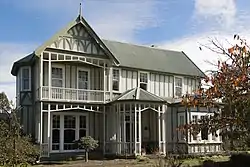Homebush | |
|---|---|
Locality | |
 Historic house at Homebush | |
| Coordinates: 40°58′26″S 175°40′23″E / 40.974°S 175.673°E | |
| Region | Wellington Region |
| Territorial authority | Masterton District |
| Ward |
|
| Electorates | |
| Government | |
| • Territorial Authority | Masterton District Council |
| • Regional council | Greater Wellington Regional Council |
| • Mayor of Masterton | Gary Caffell |
| • Wairarapa MP | Mike Butterick |
| • Ikaroa-Rāwhiti MP | Cushla Tangaere-Manuel |
| Area | |
| • Total | 103.12 km2 (39.81 sq mi) |
| Population (June 2022)[2] | |
| • Total | 1,220 |
| • Density | 12/km2 (31/sq mi) |
Homebush is a rural area in the Masterton District and Wellington Region of New Zealand's North Island. It is about 3 km southeast of Masterton.
The historic house at 10 Homebush Road was designed by Charles Natusch in 1891 for William Lucena. Lucena died very soon after the house was complete.[3]
Demographics
Homebush-Te Ore Ore statistical area covers 103.12 km2 (39.81 sq mi).[1] It had an estimated population of 1,220 as of June 2022,[2] with a population density of 12 people per km2.
| Year | Pop. | ±% p.a. |
|---|---|---|
| 2006 | 960 | — |
| 2013 | 942 | −0.27% |
| 2018 | 1,050 | +2.19% |
| Source: [4] | ||
Homebush-Te Ore Ore had a population of 1,050 at the 2018 New Zealand census, an increase of 108 people (11.5%) since the 2013 census, and an increase of 90 people (9.4%) since the 2006 census. There were 387 households, comprising 495 males and 555 females, giving a sex ratio of 0.89 males per female. The median age was 49.0 years (compared with 37.4 years nationally), with 183 people (17.4%) aged under 15 years, 141 (13.4%) aged 15 to 29, 483 (46.0%) aged 30 to 64, and 243 (23.1%) aged 65 or older.
Ethnicities were 92.0% European/Pākehā, 15.1% Māori, 0.6% Pasifika, 1.4% Asian, and 2.0% other ethnicities. People may identify with more than one ethnicity.
The percentage of people born overseas was 13.7, compared with 27.1% nationally.
Although some people chose not to answer the census's question about religious affiliation, 48.3% had no religion, 40.9% were Christian, 1.4% had Māori religious beliefs, 0.3% were Buddhist and 1.4% had other religions.
Of those at least 15 years old, 174 (20.1%) people had a bachelor's or higher degree, and 144 (16.6%) people had no formal qualifications. The median income was $36,500, compared with $31,800 nationally. 174 people (20.1%) earned over $70,000 compared to 17.2% nationally. The employment status of those at least 15 was that 453 (52.2%) people were employed full-time, 180 (20.8%) were part-time, and 21 (2.4%) were unemployed.[4]
References
- 1 2 "ArcGIS Web Application". statsnz.maps.arcgis.com. Retrieved 8 July 2021.
- 1 2 "Population estimate tables - NZ.Stat". Statistics New Zealand. Retrieved 25 October 2022.
- ↑ "Homebush". New Zealand Heritage List/Rārangi Kōrero. Heritage New Zealand. Retrieved 8 July 2021.
- 1 2 "Statistical area 1 dataset for 2018 Census". Statistics New Zealand. March 2020. Homebush-Te Ore Ore (256600). 2018 Census place summary: Homebush-Te Ore Ore